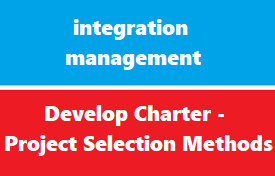introduction
as extending to process develop project charter : this article we will discuss project selection methods
let us to imagine the following scenario:
the organization you are working for has been handed a number of project contracts.
Due to resource constraints, the organization can’t handle all the projects at once, so they need to decide which project(s) will maximize profitability.
Type of project selection Methods
type of project selection Methods
1-Benefit measurement method (comparative approach )
Benefit Measurement is a project selection technique based on the present value of estimated cash outflow and inflow. Cost benefits are calculated and then compared to other projects to make a decision. The techniques that are used in Benefit Measurement are as follows:
- murder board (panel try to shutdown project idea )
- per review
- scoring model
- economic model
2- Constraints optimization (mathematical )
- linear programming
- integer programming
- dynamic programming
- multi-objective programming
- economic methods
Present Value PV
present value of project will give specific mount value in future
PV =Feature Value /((1+interest rate)^number of period)
Note : PV could also stand for Planned Value which will be used later in EVM(Earned
Value Management )
NET Present Value NPV
NET Present Value NPV =Total Benefit (income) – cost
- if result I positive >> good
- if two project have positive NPV à more value will be more benefit
Net Present Value is the difference between the project’s current value of cash inflow and the current value of cash outflow. The NPV must always be positive. When picking a project, one with a higher NPV is preferred. The advantage of considering the NPV over the Payback Period is that it takes into consideration the future value of money. However, there are limitations of the NPV, too:
- There isn’t any generally accepted method of deriving the discount value used for the present value calculation.
- The NPV does not provide any picture of profit or loss that the organization can make by embarking on a certain project.
- For more details on the NPV and how to use the NPV as a tool to filter projects out, here’s an insightful article on calculating the opportunity costs for projects.
Internal Rate Of Return IRR
Internal Rate Of Return IRR : expected return of project after specific period
- the project with more IRR >>> has better value to be selected
The Internal Rate of Return is the interest rate at which the Net Present Value is zero—attained when the present value of outflow is equal to the present value of inflow. Internal Rate of Return is defined as the “annualized effective compounded return rate” or the “discount rate that makes the net present value of all cash flows (both positive and negative) from a particular investment equal to zero.” The IRR is used to select the project with the best profitability; when picking a project, the one with the higher IRR is chosen.
When using the IRR as the project selection criteria, organizations should remember not to use this exclusively to judge the worth of a project; a project with a lower IRR might have a higher NPV and, assuming there is no capital constraint, the project with the higher NPV should be chosen as this increases the shareholders’ profits.
Cost Benefit Ratio
Cost Benefit Ratio =revenue /cost
- if result more than 1 project is good to be selected
as the name suggests, is the ratio between the Present Value of Inflow or the cost invested in a project to the Present Value of Outflow, which is the value of return from the project. Projects that have a higher Benefit-Cost Ratio or lower Cost-Benefit Ratio are generally chosen over others.
opportunity cost
opportunity cost , is value of the project that was NOT selected
Opportunity Cost is the cost that is given up when selecting another project. During project selection, the project that has the lower opportunity cost is chosen.
Low of Dimension Return
Low of Dimension Return
law of diminishing return : state that at specific point , adding more input “resource ”
will NOT produce proportional productivity
for example:
adding 10 resources to activity that assigned to one person will NOT >>> speed it 10 times
Depreciation
Depreciation :large asset purchased by company lose value
Economic Model
EVA, or Economic Value Added, is the performance metric that calculates the worth-creation of the organization while defining the return on capital. It is also defined as the net profit after the deduction of taxes and capital expenditure.
If there are several projects assigned to a project manager, the project that has the highest Economic Value Added is picked. The EVA is always expressed in numerical terms and not as a percentage
Scoring Model
the scoring model is an objective technique: the project selection committee lists relevant criteria, weighs them according to their importance and their priorities, then adds the weighted values. Once the scoring of these projects is completed, the project with the highest score is chosen
Discounted Cash Flow
t’s well-known that the future value of money will not be the same as it is today. For example, $100,000 won’t have the same worth ten years from now. Therefore, during calculations of cost investment and ROI (Return of Investment ), be sure to consider the concept of discounted cash flow.
important note
NOTE : project with HIGH priority with take advantage over all criteria
Conclusion
Project selection is the most important process for any organization.
The right project helps an organization grow its business and earn recognition.
However,
bad one can damage credibility.
Project selection techniques help you choose the right project with a better return on investment.

